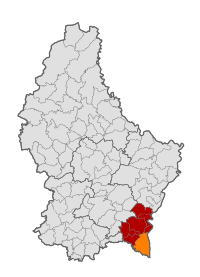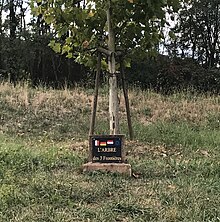
Back Schengen (Luxemburg) Afrikaans Schengen ALS شينجن (لوكسمبورغ) Arabic شينجين ARZ Şengen Azerbaijani Шэнген Byelorussian Шэнген BE-X-OLD Schengen (Luksemburg) BS Schengen Catalan Commune de Schengen (munisipyo sa Lugsemburg) CEB
Schengen | |
|---|---|
 A view of Schengen | |
 Map of Luxembourg with Schengen highlighted in orange, and the canton in dark red | |
| Coordinates: 49°28′10″N 6°21′32″E / 49.46944°N 6.35889°E | |
| Country | |
| Canton | Remich |
| Government | |
| • Mayor | Robert Beissel |
| Area | |
| • Total | 31.42 km2 (12.13 sq mi) |
| • Rank | 24th of 100 |
| Highest elevation | 302 m (991 ft) |
| • Rank | 98th of 100 |
| Lowest elevation | 141 m (463 ft) |
| • Rank | 5th of 100 |
| Population (2023) | |
| • Total | 5,196 |
| • Rank | 32nd of 100 |
| • Density | 170/km2 (430/sq mi) |
| • Rank | 47th of 100 |
| Time zone | UTC+1 (CET) |
| • Summer (DST) | UTC+2 (CEST) |
| LAU 2 | LU0001206 |
| Website | schengen.lu |
Schengen (Luxembourgish: [ˈʃæŋən] , French: [ʃɛŋɡɛn] , German: [ˈʃɛŋən]) is a small wine-making village and commune in far south-eastern Luxembourg, on the western bank of the river Moselle. The commune border includes the tripoint where the borders of Germany, France, and Luxembourg meet.
After the mergers with Burmerange and Wellenstein in 2011,[1] the commune has a population of 4,223 with an area of 31.42 square kilometres (12.13 sq mi).
The largest settlement within the commune of Schengen is Remerschen after which the commune used to be named. The name of the commune was changed in 2006[2] to take advantage of Schengen's name recognition after the signing of the Schengen Agreement there in 1985. The town of Schengen itself had a population of 679 as of 2024.[3]
Schengen Castle dates from 1390 but was almost completely rebuilt in the 19th century.[4]
- ^ "Fusion des communes de Burmerange, Schengen et Wellenstein". Legilux. Government of Luxembourg. Retrieved 13 June 2015.
- ^ "Loi du 24 juillet 2006 portant changement du nom de la commune de Remerschen en celui de Schengen" (PDF). Journal Officiel du Grand-Duché de Luxembourg: 2661. 30 August 2006. Retrieved 27 December 2012.
- ^ "Registre national des personnes physiques RNPP : Population par localité". data.public.lu. 2024-01-07.
- ^ "Das Schloss von Schengen", Schengen a.s.b.l. (in German) Retrieved 27 March 2011.

